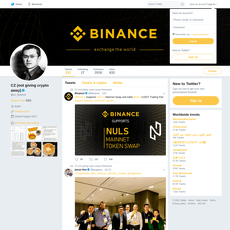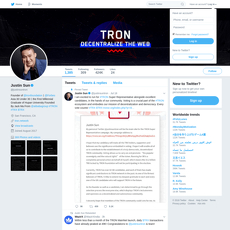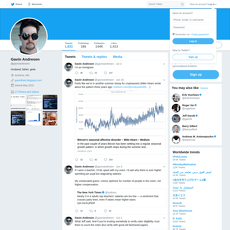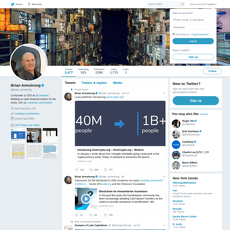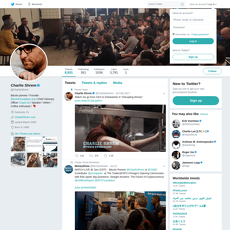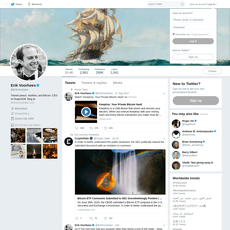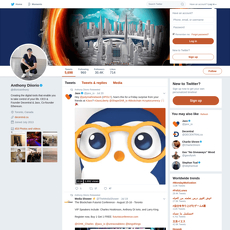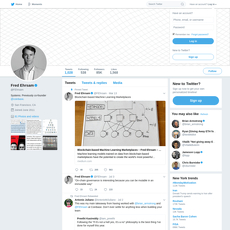Chris Larsen Review
Chris Larsen
twitter.com
Chris Larsen Review Guide: Everything You Need To Know + FAQ
Ever wondered if following Chris Larsen on X/Twitter actually helps you make smarter crypto moves? You’re not alone—and yes, there’s real signal if you know what to look for.
If you’re tracking XRP, Ripple, or the bigger payments-and-policy conversation, Larsen’s posts can be a useful cue for what matters next. The trick is separating context from noise: what’s background, what’s personal commentary, and what (if anything) might feed into Ripple’s direction.
What’s confusing people right now
Here’s why most folks feel lost when trying to use Larsen’s feed:
- Role confusion: People mix up his current role with his former CEO seat and assume every comment is company policy. It isn’t.
- Fragmented info: Details about his role, investments, and priorities live across interviews, old press, and conference talks—easy to misread if you’re catching a single viral thread.
- Impersonators and hacks: Fake or compromised accounts can spark chaos. Remember how a hacked SEC X account briefly jolted Bitcoin markets in Jan 2024 before Reuters confirmed it was bogus? Or when Vitalik Buterin’s X account was hacked and users lost hundreds of thousands of dollars?
- Scam risk on social platforms: The FTC keeps flagging social media as a major vector for investment and crypto scams, with losses in the billions reported across recent years. Data spotlight.
Bottom line: the combo of scattered sources, role misunderstandings, and social media risk makes it easy to overreact—or miss the point entirely.
What you’ll get here
I’ve built a clean snapshot you can actually use. No hype, no guesswork—just the context that matters:
- Who Chris Larsen is (and what he’s actually known for in fintech and crypto)
- How to read @chrislarsensf without confusing personal views for official Ripple statements
- Where to verify titles and claims so you don’t get tripped up by outdated bios or rumor threads
- A practical way to fold his posts into your research without overreacting to headlines
Quick reality check: influential voices can shape narratives and focus attention. That doesn’t mean they’re issuing trading signals, and it doesn’t mean every tweet moves markets.
Who this guide is for
- XRP holders who want to track Ripple-related context the smart way
- Fintech watchers who care about payments, regulation, and real-world adoption
- Crypto investors who prefer primary sources and clear, verifiable signals
Quick disclaimer
Nothing here is financial advice. Always verify roles and claims with primary sources:
- Ripple’s leadership page: ripple.com/company/leadership
- Official handle: @chrislarsensf
- Reputable outlets and official press releases
Ready for the fast, fact-checked version of who Chris Larsen is and why his perspective matters beyond price chatter? In the next section, I’ll give you the crisp bio and the fintech milestones that still shape how he talks about payments and policy today—want the quick story without the fluff?
Chris Larsen at a glance: the quick bio
Chris Larsen is a Silicon Valley entrepreneur and angel investor who has spent decades building financial infrastructure. He co-founded Ripple in 2012 with a narrow, practical aim: make cross-border payments for banks and fintechs faster, cheaper, and more reliable. Before crypto caught headlines, he helped shape two earlier waves of online finance—E-LOAN and Prosper Marketplace—which opened doors for everyday consumers to borrow and compare rates online.
I like founders who build repeatably in the same hard problem space. That’s Larsen’s through-line: create rails that move money with less friction.
What he’s known for
Larsen is most recognized for pushing the idea that financial institutions should be able to move value across borders the way the internet moves information. Ripple’s tech attacked the ugliest parts of correspondent banking—high fees, long settlement times, and opaque intermediaries.
“Money should move like email—fast, low-cost, and global.”
That principle lands because the pain is real. The World Bank has tracked average global remittance costs in the mid–single digits for years (often 6%+ depending on corridors), which eats into family transfers and business payments. If you care about the mission behind Ripple, that’s the problem set he’s been aiming at. For context, see the World Bank’s Remittance Prices Worldwide and broader policy coverage from the World Bank and the Krach Institute for Tech Diplomacy’s summaries on responsible tech and finance.
Notable companies he co-founded
- E-LOAN (late 1990s): One of the earliest online lending marketplaces. It helped normalize shopping for loans on the web and pushed transparency that traditional lenders resisted at the time.
- Prosper Marketplace (launched 2006): The first major U.S. peer-to-peer lending platform, where individual investors could fund consumer loans. That model paved the way for a broader fintech movement around marketplace lending.
- Ripple (founded 2012): Built payments and liquidity solutions for enterprises transacting across borders. The focus: real-time settlement and working-capital efficiency for banks, fintechs, and remittance providers. If you’ve seen remittance names like SBI Remit or Tranglo in the news, you’ve seen the kinds of corridors Ripple’s ecosystem targets.
Notice the pattern: not hype cycles—just plumbing. Payments pipes, credit pipes, liquidity pipes. That’s why I pay attention when he talks about infrastructure more than price talk.
Philanthropy snapshot
Larsen and his family channel a lot of energy (and capital) into education, climate, and community safety. A few concrete examples you can look up:
- Education: A widely reported crypto donation (in XRP) to San Francisco State University supported business education and entrepreneurship—covered at the time as one of the largest digital asset gifts to a U.S. university.
- Tech-for-good: Ongoing support through the nonprofit Rippleworks, which partners with social ventures to scale operations (think hands-on expertise, not just checks).
- Climate: Funding for campaigns urging lower-energy pathways in crypto—such as Greenpeace USA’s Change the Code, Not the Climate—aligns with his interest in cleaner infrastructure.
- Community: Support for local public safety and neighborhood projects in San Francisco, reflecting a habit of funding pragmatic, city-level solutions.
Whether you agree with every initiative or not, there’s a clear pattern: invest in systems—education, climate tech, civic tools—that make the broader economy run better.
If that’s the snapshot, what’s his seat at Ripple right now—hands on, or guiding from the boardroom? I’ll clear that up next so you don’t have to guess.
Does Chris Larsen still work for Ripple?
Short answer: yes—just not as the operator. He stepped down as CEO years ago and moved into a board-level role (widely referred to as Executive Chairman), where he’s been the co-founder voice focused on strategy, policy, and long-term direction. Day-to-day execution lives with Ripple’s current executive team.
“Separate personality from policy: follow the signal, ignore the noise.”
What “stepped down” actually means
In practical terms, this is how it looks:
- 2016 leadership shift: Trade-finance outlets (like TXF) and industry press covered the move when Chris transitioned out of the CEO seat and into a board/Executive Chairman role. That’s a common founder arc: less daily ops, more governance and strategy.
- Who posts the big company news now: Official moves—acquisitions, licensing, product rollouts—come from Ripple’s blog, press room, and current leaders. For instance, milestone announcements in recent years have been led by the CEO, President, or CLO via Ripple’s channels, not Chris’s personal feed.
- What you’ll see on his X account: Chris often shares policy views, financial-inclusion themes, climate/tech takes, and high-level comments about payments. It’s context, not corporate directives.
Real sample that kept markets guessing: when he confirmed in early 2024 that his personal XRP wallets were compromised, some traders initially reacted as if it were a Ripple treasury issue. It wasn’t—and Ripple clarified that. This is exactly why separating personal updates from company policy matters for your portfolio and peace of mind.
Why this matters to XRP holders and partners
- Narrative vs. policy: A co-founder’s perspective can inform how Ripple thinks about regulation, corridors, and infrastructure—but policy changes and product decisions show up first in official Ripple statements.
- Market psychology is real: Crypto has a history of reacting to high-profile accounts (we’ve all seen how a single post can swing DOGE or BTC headlines). With Chris, the signal is usually long-term outlook—not short-term catalysts.
- Risk management: Don’t re-position based on a single personal tweet. If something sounds like company news, wait for the blog or press page to back it up.
Where to verify current titles
When you see claims floating around, do a 60-second check:
- Ripple leadership page: the up-to-date roster is here: ripple.com/company/leadership/
- Ripple’s official news/blog: for announcements and role language: ripple.com/insights/ and ripple.com/company/news/
- Chris’s verified account: cross-check tone and topics at @chrislarsensf. If a post sounds like “policy,” look for a matching Ripple link.
- Time-check with Wayback: if you’re researching history, use the Wayback Machine to confirm older leadership snapshots and press language.
If those sources don’t align, default to Ripple’s own pages and verified releases. That’s your ground truth.
Quick gut-check I use: If it affects customers, licensing, products, or XRP programmatics, I wait for the Ripple URL. If it’s about policy, climate, or broader payments narratives, I treat it as context for my research—not a trading trigger.
Curious what his investment trail says about the themes he cares about (fintech rails, climate tech, infrastructure)? That’s where the real tells often live. Ready to peek into the companies he’s backed and what that signals for crypto’s next phase?
Chris Larsen’s investments: what PitchBook and public sources show
If you really want to understand how Chris Larsen thinks, don’t stare at price charts—follow the checks. PitchBook’s profile of his activity points to a consistent pattern: he funds the rails. That means financial software on one side and climate/clean-tech hardware on the other, a combo that looks less random when you remember his Ripple-era focus on faster, cheaper, cleaner payments for institutions.
“Invest in the plumbing, not the perfume—the infrastructure outlasts the narrative.”
Sectors he backs
From what PitchBook and public mentions show, two themes keep showing up. They’re practical, not flashy—and that’s the point.
- Fintech and financial software: Think compliance tooling, liquidity and treasury software, cross-border B2B rails, and enterprise-grade integrations. These are the boring-but-critical layers that banks and payment companies need to move real money safely and at scale.
- Climate and clean-tech (including alternative energy equipment): Technologies that reduce energy use, capture or repurpose carbon, improve grid efficiency, or unlock cleaner generation. This isn’t a side quest—global capital is already tilting this way. The IEA estimates clean energy investment will be around $2 trillion in 2024, and BloombergNEF tracked a record energy transition spend in 2023. Betting on cleaner infrastructure is no fringe thesis.
Sample portfolio names
PitchBook cites companies like Yellow, Aircela, and Sparrow in Larsen’s investment trail. Categories and rounds can change, so always cross-check the latest status—but the pattern holds: infrastructure, efficiency, and system-level upgrades.
- Yellow — Listed by PitchBook among his bets. The name has shown up in energy and software contexts; either way it aligns with his “build the rails” mindset. Verify current categorization before you model anything off it.
- Aircela — Public sources describe efforts around climate/energy tech (for example, converting CO₂ into useful products or energy-adjacent systems). That’s squarely in the “cleaner, more efficient infrastructure” lane.
- Sparrow — The label pops up across fintech and trading infrastructure in various databases. Again, check the specific entity and geography, but the theme (financial rails) tracks.
Pro tip: these names can overlap with unrelated startups that share the same wordmark. Always validate with the company’s site, recent press, and investor disclosures before you treat them as definitive signals.
What this signals to crypto folks
- Infrastructure-first thinking: Larsen consistently backs the “pipes,” not the perfume. In crypto, that translates to interest in rails that make value move reliably—interoperability, liquidity hubs, compliant on/off-ramps, and tools banks can actually use.
- Efficiency and sustainability matter: A tilt toward alternative energy and climate tech suggests he believes market and policy tailwinds will reward lower-carbon, higher-efficiency systems. For crypto, that favors energy-efficient networks, verifiable sustainability claims, and providers that can pass ESG due diligence with banks and corporates.
- Institutional readiness over retail hype: Financial software bets signal a bias toward enterprise-grade reliability—payments compliance, AML/KYC tooling, and integration with existing rails. If you’re tracking where institutional adoption meets crypto, this is the lens.
- Signals, not signals noise: When an investor’s checkbook clusters around “real-world utility” themes, their commentary on payments, liquidity, and policy isn’t random. It’s the strategy showing through.
So here’s the fun part: how do you read @chrislarsensf through this investment lens—spotting the policy and infrastructure cues without overreacting to headlines? Keep going; next up I’ll show you what to expect from his feed and how to separate context from catalysts. Ready to look at what his posts actually say (and don’t)?
What to expect from @chrislarsensf on Twitter
When I open Chris Larsen’s feed, I’m not expecting trading calls—I’m looking for signal about how payments, policy, and climate intersect with crypto. His posts tend to be high-level, measured, and focused on systems, not spikes. Think policy threads, links to credible research, and reflections on where money movement is going next.
“Signal beats noise when you know what to look for.”
Topics and tone
Here’s the cadence I typically see:
- Payments infrastructure: cross-border friction, liquidity, interoperability, and how banks, fintechs, and public networks might connect in the real world.
- Regulation and compliance: commentary on clarity from U.S. agencies, global rules (you’ll sometimes see references to frameworks like MiCA or FATF), and why predictable policy unlocks enterprise adoption.
- Climate and tech policy: energy efficiency, sustainability standards, and clean-tech progress—consistent with Ripple’s public sustainability stance and industry initiatives like the Crypto Climate Accord.
- Industry snapshots: notes on what incumbents (banks, PSPs) and startups are actually doing, not just what they’re promising.
The tone is responsible innovation over hype—closer to an operator sharing context than a speculator sharing price targets.
Reading signals without overreacting
I treat his posts as context to refine my thesis, not candles to trade. Here’s my quick filter:
- Separate personal perspective from company news. If it’s official, it usually lands on Ripple’s newsroom or blog first, then gets echoed by executives. A personal take that says “excited about X” is not the same as “today we launched X.”
- Anchor to a primary source. If Larsen links to a policy memo, whitepaper, or press release, I read the source and note what’s actually being said. If he comments without a link, I look for a reputable report that matches the claim before I move a muscle.
- Watch the wording. “We” language about Ripple plus a link to ripple.com is stronger than a general industry comment. If there’s no link and no corroboration from Ripple leaders, I wait.
- Time matters. Posts that land during regulatory hearings, bank failures, or major partner announcements can color sentiment but still aren’t directives.
Why so cautious? Research keeps reminding us that social media can sway crypto in the short run. For example, multiple studies in peer-reviewed outlets like Finance Research Letters found that Twitter sentiment can predict short-term crypto returns—useful for context, but the effect is fleeting and noisy. That’s exactly why I verify and wait for official communications when a post sounds like company news.
Security note: impersonators exist
Scammers love high-profile crypto accounts. Here’s how I keep my feet on the ground:
- Use the verified handle only: @chrislarsensf. Beware of subtle misspellings or extra characters.
- Cross-check identity: confirm via links from Ripple’s official site or press releases. A blue check on X isn’t identity proof by itself.
- Zero tolerance for giveaways: if you see “send 1 XRP, get 2 XRP,” it’s a scam. Larsen isn’t DM’ing you for funds, seed phrases, or “beta access fees.”
- Look at account history: long-lived post history, credible follower networks, and consistent messaging beat freshly spun-up clones with aggressive replies.
Bottom line: I treat Larsen’s feed like an early-warning radar for where policy and payment rails are trending, not a green button to press. Want to turn that radar into a repeatable edge without getting whipsawed? In the next section, I’ll share the quick playbook I use to convert his posts into clean research signals you can actually act on—curious what the three checks are that save me the most time?
Turn Larsen’s posts into useful research (without the noise)
When Chris Larsen posts, I don’t chase the headline—I turn it into structured research I can act on later. The goal is to extract signal on policy and payments without getting pulled into knee-jerk trades. Here’s exactly how I run it.
My simple playbook
- Tag the theme in seconds. I label each post with a simple tag: policy, payments, regulation, or climate. This sounds basic, but it makes later filtering effortless.
- Open two tabs for corroboration. If it’s about policy or regulation, I look for a primary source (agency release, bill text, speech transcript). If it’s payments, I check for partner or industry confirmation (bank blog, network announcement, conference agenda).
- Hold for official Ripple comms. If a post touches Ripple, I wait for the company blog or a press release before changing any thesis. In 2023, official legal and policy news routinely moved markets more than commentary—patience pays.
- Note the posture, not the price. Larsen talks infrastructure and policy. I ask: does this reinforce a trend (compliance-first rails, liquidity, interoperability)? If yes, I update my long-term notes; if no, I file it as “watch.”
- Create a one-line “if/then.” Example: “If EU payments policy shifts toward standardized real-time settlement, then cross-border corridors that align with ISO 20022 and liquidity solutions likely gain tailwind.” That keeps me from overreacting to one post.
- Use a short no-trade window. I give myself 30–90 minutes before making any move after seeing a high-engagement post. Research in Finance Research Letters has shown social sentiment can affect short-term crypto returns and volatility—useful to know, but not to get trapped by.
Rule I live by: “Commentary informs my research; official filings change my positioning.”
Real-world samples of what this looks like:
- Policy-thread day: If Larsen links to a central bank or regulator speech about cross-border rails, I pull the transcript, skim for keywords like “interoperability,” “settlement finality,” and “liquidity,” and add a 3-bullet summary to my payments notes. No thesis change without a published roadmap.
- Industry-collab hint: If he amplifies a conference panel on instant payments, I check the agenda and speakers. If I see Tier-1 banks or payment networks discussing ISO 20022 adoption, I tag it “infrastructure momentum” and track follow-up announcements over the next quarter.
- Regulatory chatter: If a thread touches U.S. or EU crypto policy, I cross-check committee calendars and staffer memos. I want dates and documents—not threads—before I assume impact.
Why this works: social-media-driven attention tends to create short-lived spikes, but durable value comes from confirmed policy shifts and enterprise adoption. Event-heavy periods—court rulings, agency updates, earnings—move the needle far more than any single tweet. I treat posts as road signs, not destinations.
Tools and resources I keep handy
- X lists and columns: I keep Larsen in a policy/fintech list, separate from price chatter. It keeps the signal clean.
- Primary sources bookmarked: Ripple’s blog, major regulators, central banks, and top-tier finance/tech outlets for quick verification.
- Research scratchpad: A lightweight doc with my four tags, quick links to leadership pages, and a template for those “if/then” lines.
- Calendar + alerts: Earnings calendars and policy hearings next to my feed, so I know when a post is landing into a news-heavy moment.
Mini timeline matters
A tweet at 8:30 AM ET on a policy hearing day means something different than the same tweet on a quiet Friday. I keep a tiny two-line timeline next to every notable post:
- What else is happening today? Policy hearings, central bank speeches, partner earnings, or major industry conferences.
- What just happened? Any ruling, pilot launch, or standard update in the last 48 hours that could color the interpretation.
That micro-context is the difference between “interesting commentary” and “early heads-up on a direction the industry is already moving.”
Quick sanity check I use: “Can I tie this post to a document, a date, and a decision-maker?” If not, it’s a note—not a narrative change.
Want the quick, straight answers people keep asking about Larsen—role, investments, and whether his feed is worth your time? I’m laying those out next so you can make the call without guesswork. Ready for the rapid-fire FAQ?
FAQ: Straight answers to what people ask about Chris Larsen
What is Chris Larsen known for?
He’s a fintech entrepreneur and angel investor best known for co-founding Ripple in 2012 to make cross-border payments instant and low-cost for financial institutions. Before that, he co-founded E-LOAN and Prosper, two early movers in online lending.
For a concise profile that lines up with this track record, check the Krach Institute’s site (techdiplomacy.org) and search for “Chris Larsen.”
Does Chris Larsen still work for Ripple?
He moved out of the CEO role years ago and has been recognized as a co-founder and board-level leader since. If you need the exact current title, don’t guess—verify it.
- Ripple leadership page: ripple.com/company/leadership
- Official Ripple updates: ripple.com/insights
- His account for personal posts: @chrislarsensf
- Historical coverage of the CEO step-down exists in trade outlets (e.g., TXF—start at txfnews.com and search)
Remember: personal tweets are not the same as official company policy. Operational announcements come from Ripple’s current executive team.
What are Chris Larsen’s investments?
Public data aggregators show he backs fintech/financial software and climate-focused plays (alternative energy equipment, sustainability). PitchBook cites examples like Yellow, Aircela, and Sparrow. These ecosystems change quickly, so confirm the latest:
- PitchBook investor and company profiles: pitchbook.com (paywalled)
- Cross-check on Crunchbase: crunchbase.com
- Company websites and press releases for round details
Theme-wise, he tends to support infrastructure—things that make money movement faster, cleaner, and more compliant. That lens shows up in how he talks about payments rails and liquidity.
Is following @chrislarsensf worth it?
Yes—if you care about the policy and infrastructure side of crypto and cross-border payments. Expect commentary on regulation, payments, tech policy, climate, and the long-game for real-world adoption. It’s not trading advice.
Why I follow:
- Policy momentum: hearings, enforcement trends, and how rules shape banking/payment rails
- Global payments: interoperability, corridors, and institutional adoption signals
- Sustainability and tech governance angles that touch crypto at the infrastructure layer
What the research says: influential accounts can affect crypto attention and short-term volatility—see Ante (2021) on market reactions to high-profile tweets (SSRN), and Kraaijeveld & De Smedt (2020) on Twitter sentiment and Bitcoin returns (SSRN). Larsen’s tone is more policy-forward than pricey, but the broader point stands: social signals can shape narratives.
Pro tip: treat his posts as context, not catalysts. If a post sounds like company news, wait for the official Ripple announcement before you act.
Security note: use the verified handle and be wary of DMs, giveaways, or anything asking you to send funds. He’s not asking you for money.
Final thoughts
Larsen’s career is about building rails, not hype. Follow him to sharpen your understanding of payments, policy, and real-world adoption—and always confirm breaking claims with primary sources. If you want more practical breakdowns like this, I’ll keep them coming on Cryptolinks.com.
CryptoLinks.com does not endorse, promote, or associate with Twitter accounts that offer or imply unrealistic returns through potentially unethical practices. Our mission remains to guide the community toward safe, informed, and ethical participation in the cryptocurrency space. We urge our readers and the wider crypto community to remain vigilant, to conduct thorough research, and to always consider the broader implications of their investment choices.


